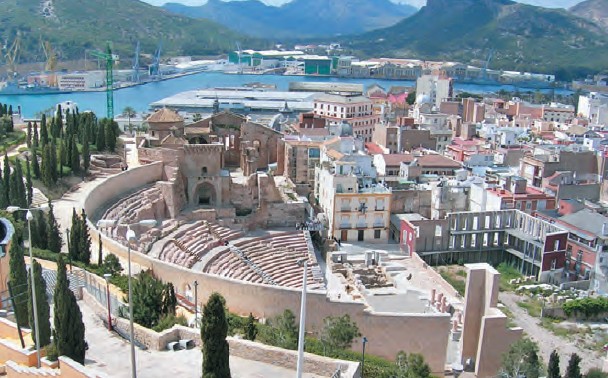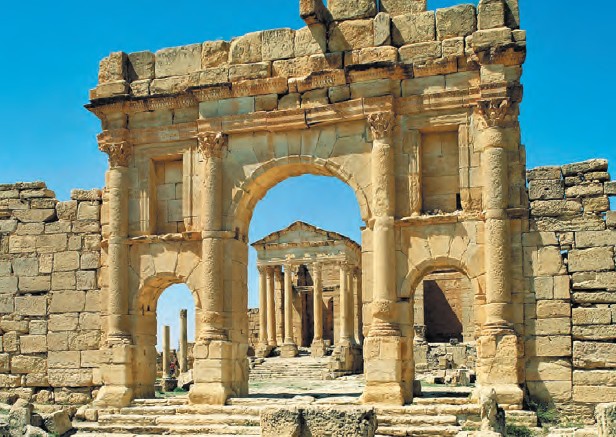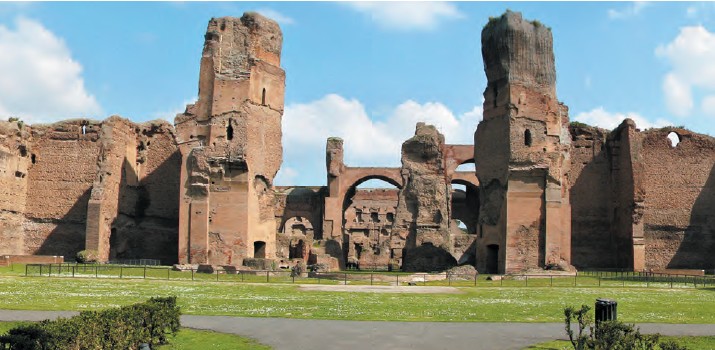Carthage
India Outbound
July-Aug 2015
In North Africa, Tunisia is a rare gem that provides a very rich mix of European and Arab heritage. The Roman ruins of Carthage are a stellar example of the treasures waiting to be discovered there.
When you land at the Tunis airport in the capital of this tiny, North African nation, wedged between two much larger nations, Algeria and Libya, you may be excused if you felt that you are still in Europe.
Tree-lined boulevards, with beautiful cathedrals and skyscrapers greet you as you drive rapidly into the city centre. Of course, all the lifestyle retail brands from back home, continue to greet you on the Tunisian roads as do the houses and buildings constructed in the typical Mediterranean architectural style, with the blue and white colour scheme that takes you straight back to Greece.
Tiny though Tunisia may be, it has a rich variety of attractions for tourists, offering something for nearly every kind of tourist. To the north and the east, it has lovely Mediterranean beaches, like Sfax, Bizerte, Sousse and the Djerba island, with deep blue skies to match the colour of the sea that separates North Africa from Southern Europe and the white sands to go with the gentle surf rising from the tides.
In the west, towards the border with Algeria, lie rocky mountain ranges, with the summit Jebel Chambi rising at 1,544 m and then, there is, of course, the Sahara desert in all its glory. While millions visit Tunisia soaking in its natural charms and beauty, the country is also high on the tourist circuit due to its manmade structures and one of the most famous and visited spots is an ancient city state that almost brought the mighty Roman empire to its knees and changed the course of history.
The Early History
Carthage had its roots in the Phoenician period, when the kingdom based in today’s Lebanon had emerged as a strong power in West Asia. The first serious opponent of Rome, Carthage took the Romans to the very brink of defeat in a series of wars that lasted nearly a century. Over time, the Phoenicians established several bases in north Africa, starting with Lixus in Morocco in 1100 BC around the same time as they founded Gadir (today’s Cadiz) in Spain. By the 8th century BC, the Phoenicians had also reached the coast of Sicily. Though the exact age of Carthage remains a subject of discussion amongst the experts, it is believed to have been founded between 9th and 8th century BC. Though it was relatively late on the scene, Carthage had been blessed by nature’s bounty in the form of abundant fresh water and a lagoon rich in fish, besides its geographically strategic location that put it right in the middle of the Mediterranean Sea, making its an ideal trading post.
At the time when Carthage was rising, Tyre, the capital of Phoenicia had been a decline as Assyrians swept in increasing force across the Middle East, pushing Tyre and its rulers in a corner. Pretty soon, Carthage began to emerge as an alternative power centre for the Phoenician kingdom.
Around 550 BC, the arrival of Mago on the seat of power infused new dynamism into Carthage and its rapidly expanded its power overseas, even though at home, it remained fairly democratic with a Council of Elders and a People’s Assembly helping in the governance. Carthage began taking on the Greeks in a battle for control of southern Europe though the Greeks dealt a serious blow in a battle in 480 BC.
Building Its Strength
The seven decades were spent by Carthage in rebuilding itself and its economic might by spreading in larger parts of Africa and going on towards the Atlantic coast in Europe and Africa. By 410 BC, with the advent of a powerful king at the throne, Carthage began a ferocious military campaign in Sicily, which led to total destruction and death of thousands of soldiers of Silenus, an ally of the Greeks. The Carthagians earned their notoriety for cruelty due to the vicious killings that followed in this war.
Around 306 BC, Carthage entered into a treaty with another rising power which was fighting the Greek influence – Rome. The two agreed to divide any territory that their combined armies would conquer in battles against the Greeks. However, the alliance could not stand the test of time and within 30 years, Romans and Carthagians were waging proxy wars against each other. The first direct battle between the two occurred over the control over Sicily, which had been attacked by the Romans. This battle was won by the Romans, forcing the Carthagians to adopt guerilla tactics, halting the Roman advance over its territories. By 259 BC, the tide had turned and the Romans were defeated in a battle in which over 3000 Roman soldiers were killed.

The Roman Theatre of Carthago Nova and Cathedral ruins of Cartagena in the region of Murcia, South Eastern Spain
However, the Romans managed a revenge victory on Carthage within a couple of years. But then domestic politics interfered with the Roman campaign, once again allowing Carthage the upper hand and sure enough in the battle of Bagradas, the Romans were defeated again.
After a succession of wars, finally the two sides reached an agreement, dividing their spheres of influence in the western Mediterranean. The agreement gave Carthage control over large tracts of Spain and North Africa.
In 219 BC, Hannibal Barca, the most famous Carthagian ruler, led an unprecedented attack on Saguntum, an independent city on the Spanish coast that had attacked nearby Carthaginian towns. According to the treaty that ended the First Punic War, the Ebro River was the northernmost border of Carthage’s influence in Spain; though Saguntum was south of the Ebro, it was allied with Rome, which saw Hannibal’s attack as an act of war. Carthaginian forces besieged Saguntum for eight months before the city fell. Although Rome demanded Hannibal’s surrender, he refused, instead making plans for the invasion of Italy that would mark the beginning of Second Punic War.
Leaving his brother, also named Hasdrubal, to protect Carthage’s interests in Spain and North Africa, Hannibal assembled a massive army and marched nearly 1,700 km through the Pyrenees, across the Rhone River and the snowcapped Alps, and finally into central Italy. This is still remembered as one of the most famous military campaigns in history. With his forces depleted by the harsh Alpine crossing, Hannibal met the powerful army of the Roman general Publius Cornelius Scipio on the plains west of the Ticino River. Hannibal’s cavalry prevailed, and Scipio was seriously wounded in the battle. Late in 218 B.C., the Carthaginians again defeated the Romans on the left bank of the Trebia River, a victory that earned Hannibal the support of allies including the Gauls and Ligurians. By the spring of 217 B.C., he had advanced to the Arno River, where despite a victory at Lake Trasimene he declined to lead his exhausted forces against Rome itself.
The Battle of Cannae
In the summer of the following year, the two sides battled again near the town of Cannae and once again the Romans lost and their defeat at Cannae stunned much of southern Italy, and many of Rome’s allies and colonies defected to the Carthaginian side. However, the taste of victory for the Carthagians was short-lived. Under the leadership of Scipio’s son-in-law, also named Publius Cornelius Scipio, and his fellow general Quintus Fabius Maximus, the Romans soon began to rally. In southern Italy, Fabius used cautious tactics to gradually push back against Hannibal’s forces, and had regained a considerable amount of ground by 209 B.C. In northern Italy in 208 B.C., Roman forces defeated an army of reinforcements led by Hannibal’s brother Hasdrubal, who had crossed the Alps in an attempt to come to Hannibal’s aid.
Meanwhile, the younger Scipio drew on Rome’s seemingly inexhaustible supply of manpower to launch an attack on New Carthage and drive the Carthaginians out of Spain. He then invaded North Africa, forcing Hannibal to withdraw his troops from southern Italy in 203 B.C. in order to defend his home state. The following year, Hannibal met Scipio’s forces on the battlefield near Zama, some 120 kilometers from Carthage. This time it was the Romans who defeated the Carthaginians roundly, killing some 20,000 soldiers at a loss of only 1,500 of their own men. In the peace agreement that ended the Second Punic War, Carthage was allowed to keep only its territory in North Africa but lost its overseas empire permanently. It was also forced to surrender its fleet and pay a large indemnity in silver, and to agree never again to re-arm or declare war without permission from Rome.
The Roman Influence
In 146 BC, Carthage fought its last war and was again defeated after a prolonged seige of the city by the Romans, who nearly razed the city-state to the ground. However, Carthage did rise again, in 123 BC and as a Roman city this time and as the first Roman colony outside Italy. The city was rebuilt by successive Roman emperors, notably Julius Ceasar and Augustus. The ruins that attract the tourists are largely the remnants of the massive structures constructed during the reigns of Ceasar and Augustus.
Its rich history ensured that Carthage had evolved as an exceptional place of mixing, diffusion and blossoming of several cultures that succeeded one another over nearly a millennium, this metropolis and its ports have encouraged wide-scale exchanges in the Mediterranean. The city has been recognised as a World Heritage Site by UNESCO, pushing Carthage high up on a tourist’s agenda in Tunisia.
The property comprises the vestiges of Punic, Roman, Vandal, Paleochristian and Arab presence. The major known components of the site of Carthage are the acropolis of Byrsa, the Punic ports, the Punic tophet, the necropolises, theatre, amphitheatre, circus, residential area, basilicas, the Antonin baths, Malaga cisterns and the archaeological reserve.
In the 1st century CE, Augustus founded Colonia Julia Carthago, a city that once again proved the skills and the power of the people of this region. Within a few years it prospered and soon became only second to Rome in splendour and wealth. In 439 the Vandal king Genseric occupied Carthage and made it his capital. In 637 Carthage was captured by the Arabs and destroyed, and since then never regained its importance, largely owing to the concentration of power in nearby Tunis.
The Punic port is the best place to visit, as Carthage was a seaport that was stronger on the seas than the Roman Empire for many years. The port, based on a circular canal of about 100 m in width, even in those days, had the capacity to handle nearly 220 ships, not a modest number even by today’s standards. Near the port stands the Carthage museum with hundreds of artefacts discovered by archaeologists here – lamps, vases and of course statues.
Most modern archaeologists agree that child sacrifice was performed by the Carthaginians at the site of the Tophet, just a few hundred metres from the Punic port. The Tophet (not the original name, but the biblical name for sanctuaries for child sacrifice in the Middle East) lies next to a sanctuary dedicated to Baal Hammon and Tanit, but little remains of this.
An example from the period of Roman rule is the Antonine Baths, constructed from AD 145 to AD 165, which reflect the extent to which Carthage was an important and rich city even after the Roman conquest. Built between AD 146 and 162, in the reign of the Emperor Antoninus Pius, they were extensively restored in AD 389.
The baths were the largest built by the Romans outside of Rome and indicate the importance that Carthage held for them. The largest pool compared favourably with today’s Olympic-sized pools. Large parts of the baths at the lower level have survived the tests of time and are definitely an insight into the lives and times of the era.
Behind the baths is the archaeological park with its rectangular grid of streets, clearly displaying the layout of Roman Carthage’s residential quarter. The park also has Punic graves of the 6th and 5th century BC as well as a five-aisled Basilica of Douimes, dating from the 6th century AD and Chapelle Sainte Monique, an underground burial chapel from 7th century AD. All over the site are the remains of Roman cisterns, and under a tree are numbers of limestone “cannonballs”, projectiles from Carthaginian arsenals.
Also remarkable is the presence of the Cathedral of St Louis on the hill overlooking Carthage: it was built in the 1890s on the spot where the French King Louis IX died in 1270. Today the cathedral is used only for cultural purposes.
And no Roman city could perhaps be complete without a theatre, so Carthage had its own theatre as well. Though it has been rebuilt since the Roman era, it offers a glimpse into the life in Carthage in that period.
How to reach
The main international airports are Tunis- Carthage, Monastir and Djerba. Tunis has excellent connections via Middle East as well as Europe. Tunis–Carthage airport is 8 km northeast of the capital Tunis. Airport-city shuttle buses, taxis, rented cars are also available at the airport. Carthage (16.5 km) is very easy to reach from Tunis. Regular trains leave from the Tunis Marine TGM station in the Ville Nouvelle and stop at all 6 stations in Carthage. It is a 30-minute ride.
Where to stay
You’re spoilt for choice when it comes to places to stay in Tunis. Accommodation varies in price and quality depending on which region and season you choose to visit. There are multiple options for five, four and three star resorts.












